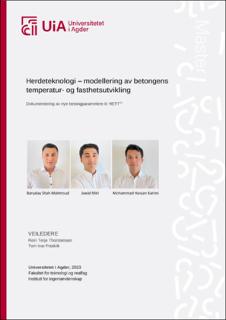| dc.description.abstract | For many years, Heidelberg Materials Cement Norway has offered the Norwegian concrete market the curing technology software HETT97. This software is a planning tool for simulating temperature and strength development in constructions. In addition, the program considers the concrete composition, heat and strength development and conditions such as construction type, formwork types and weather conditions etc. This is crucial for proper planning of casting work, such as preventing freezing of fresh concrete in accordance with NS-EN 13670 +NA, which specifies that concrete must not freeze at temperatures below 0 °C until the achieved compressive strength in the concrete surface reaches 5 MPa. Additionally, high temperatures should be avoided in accordance with NS-EN 13670 +NA, which sets a maximum concrete temperature of 70 °C. A new version of the program, called HETT22, was released on October 25, 2022. It features a completely new user interface, enhanced functions, and an updated database for various types of concrete.
To fully utilize the program's benefits, it is important to obtain the necessary documentation for determining the property functions of a concrete composition, measuring temperature development in an insulated box, and analyzing strength development at different temperatures. The concrete database in HETT22 aims to expand with concretes that meet the various low-carbon classes defined in the Norwegian Concrete Association publication no. 37, as these concrete types are increasingly in demand for projects.
The objective of this master's thesis is to investigate how different binders affect concrete's temperature sensitivity, strength, and heat development. Extensive laboratory work has been conducted, consisting of 19 recipes with different cement types, resistance classes, and varying fly ash and silicafume content. These results were implemented into HETT22 software to expand the database. Furthermore, HETT22, with its new concrete compositions, will be used to simulate a chosen construction type. For each recipe, a 15-liter curing box was cast following NS 3657. To verify the results from the 15-liter curing boxes, two 1m3 curing boxes were also cast according to the Norwegian Road Administration's “Bruprosjektering” N400.
The findings of this master's project revealed that several factors must be considered when examining concrete's temperature sensitivity, strength, and heat development. Key factors include the amount of silicafume and fly ash content, durability classes, low-carbon classes, and cement types.
Among the different categories, it was observed that an increasing dosage of fly ash leads to a reduction in concrete's temperature sensitivity, temperature and heat development, as well as a decrease in strength development up to 28 days at 5 and 20 °C. However, at 35 °C, the results show the opposite pattern. | |
